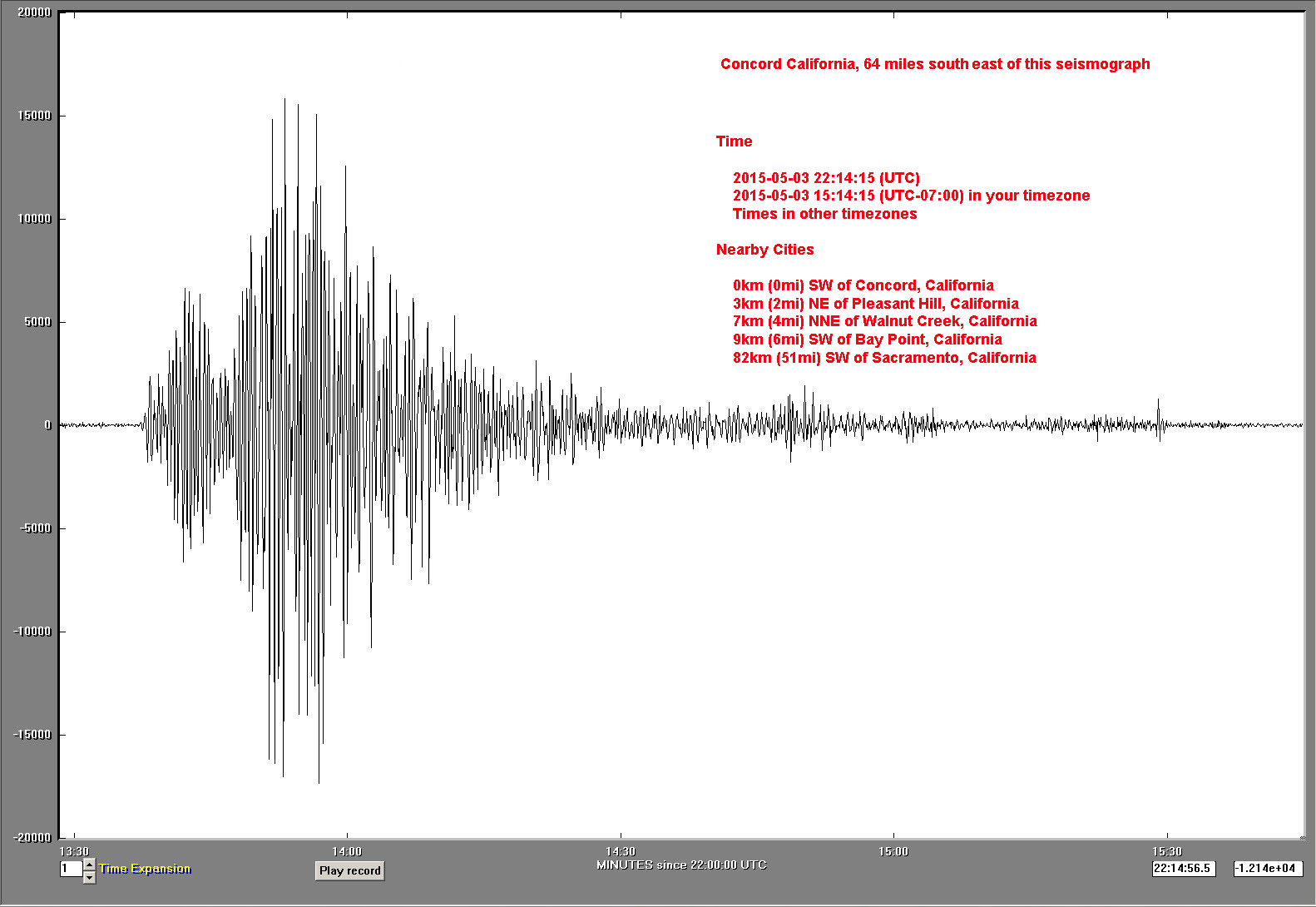
|
Seismology and the 24 bit ADC Ultra High Gain Possibilities |
For a general technical information discussion including code and schematics in the application of the LTC2440 ADC please visit this page: http://www.steveluce.com/24bits/Applications of the LTC 24 bit ADC.html This seismology page is being revised - it will be changing over the next month or two. I am looking for a way to show a complete event and 1900 pixel monitors are not a good way to see a major seismograph in detail. Some links will not work until I get this page format redesigned
RECENT NOTABLE EVENTS FROM MY SEISMOGRAPH'S POINT OF VIEW (Located in Monte Rio California - about 50 miles north of San Francisco) |
| BEGIN RECENT SELECTED EXAMPLES OF EARTHQUAKES |
| Concord California M 4.0 3 May, 2015 64 miles south east of this seismograph |

FERNDALE, CALIFORNIA M 5.7 28 JAN 2015 160 miles (258 meters) north of my seismographMove the bottom right-left slide bar on your browser to see the entire trace - this is image is 3800 pixels wide and more than 20 minutes (minimum) of activity. |

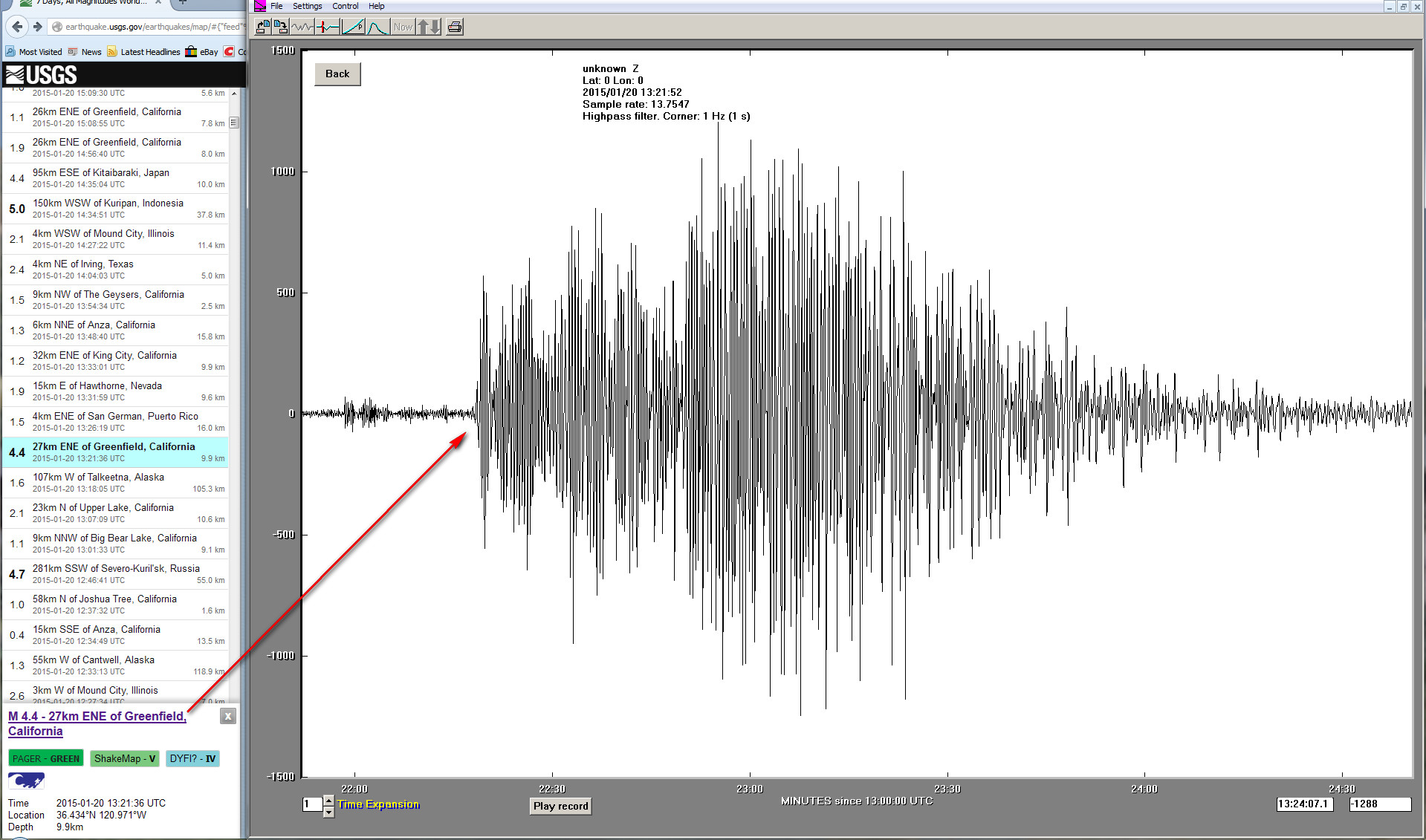
M 6.1, Napa Valley Area
40 MILES (53 meters) south east of my seismographThe is an M 6.1 in our area (the San Francisco Bay Area, just south of Napa Valley ) at 10:20:44 UTC on August 24, 2014.
 |
NAPA AFTER SHOCK
40 (53 meters) south east of my seismographThe image below is one of the larger aftershocks from
the M 6.1 American Canyon (Napa) event. Please use your browser, bottom slide
bar, to see the entire image.
This aftershock is about 2 hours after the M 6.1 event.
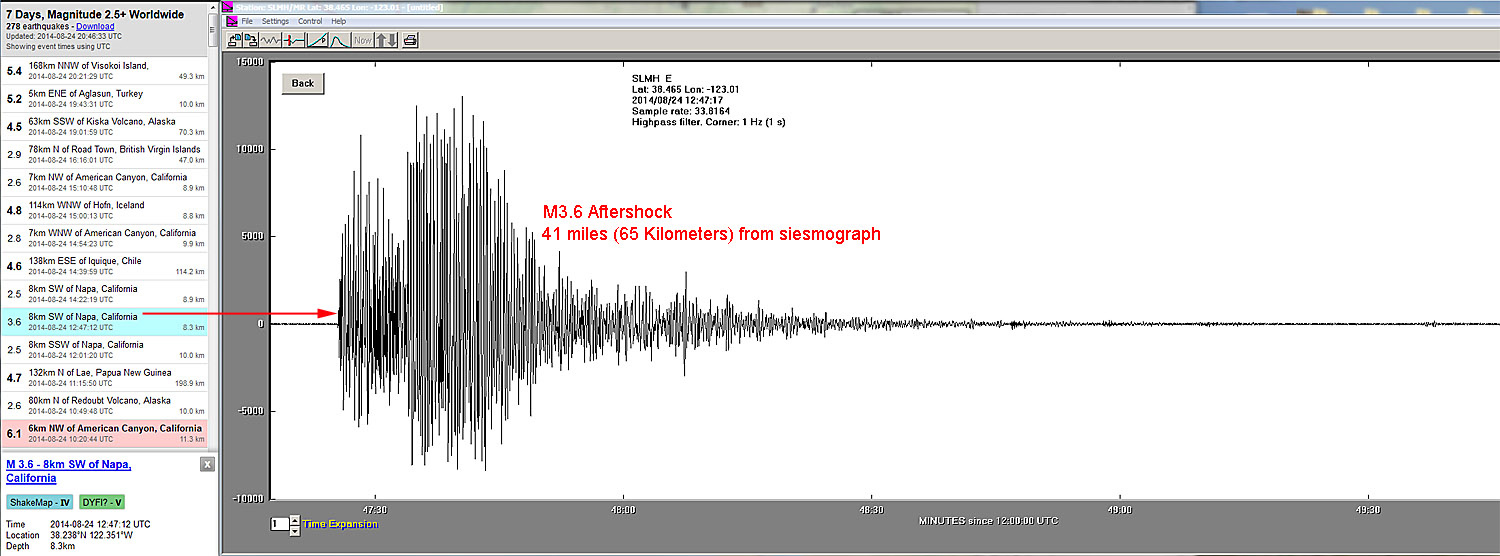
This image is two screens wide...please use your bottom browser slide bar below,
to see the entire image
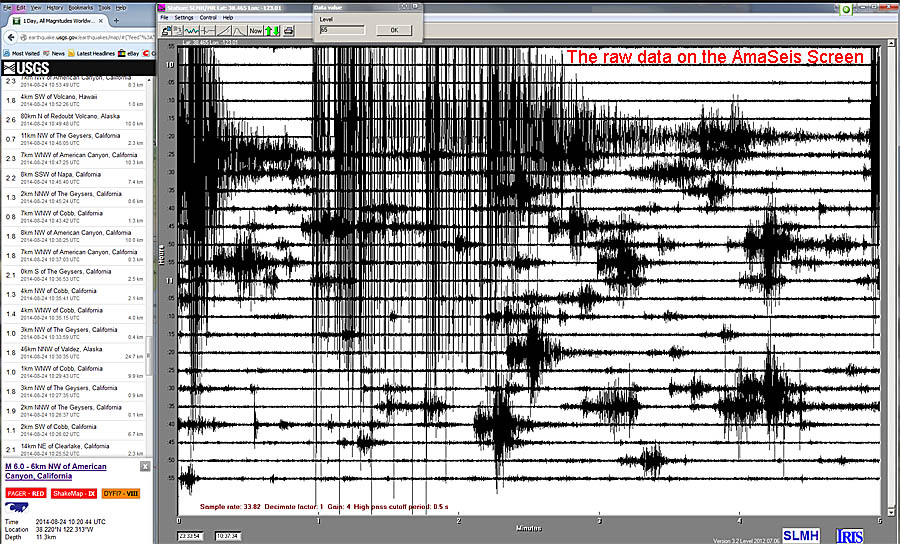
| END RECENT EARTHQUAKE LIST |
BACK TO THIS WEBSITE AND ITS GENERAL PURPOSE
|
On this page you will find... Specific applications of the LTC2440 to Seismology This page is dedicated to the use of the 24 bit ADC in Seismology. There are seismograph mechanical drawings, actual sample seismographs and limited information on the details of the LTC2440 circuit. If you are interested in seismographs please stay on this page. The seismograph page is below On a separate page you will find... General applications of the LTC2440 with specific code and schematics to get the LTC2440 started If you interested in the general use of the 24 bit LTC2400 and the LTC2440, I have developed a second page that covers the electronics, processor, and code in great detail. It is a page that lists various ADC circuits, applications, circuit construction, component suggestions, processor explanation, and processor code. This electronics page is the general application of the LTC2440 and a few sample applications such as a 6 place volt meter, the use of weather sensors, etc. The page also discusses other subjects such as high gain noise, circuit construction, working with gains of up to one million, and what it will take to get to 21 bits (one part in 2 million) with a 24 bit ADC. This is a detailed electronics, processor, and code page. And of course you can move back and forth as you please. To the electronics page: LTC2440 APPLICATIONS, SCHEMATICS, AND CODING |
WELCOME TO THE SEISMOLOGY PAGE
| TABLE OF CONTENTS OF THIS PAGE |
| INTRODUCTION
AND SYSTEM BLOCK DIAGRAM - An introduction to this page,
seismograph construction and 24 bit ADCs. SEISMOGRAPH DRAWING WITH COMMENTS - A basic drawings of my present seismographs on which I am testing the ADC electronics. SEISMOGRAPH EXAMPLES - A collection of sample seismographs captured over the past two weeks including local and long distance events. SEISMOGRAPH CIRCUIT DESCRIPTION - A quick description of the electronics and why each component was chosen. SEISMOGRAPH SCHEMATIC - A complete schematic of the latest version of the electronics - but subject to change almost daily. REFERENCE MATERIAL - some of my source information. SEPARATE PAGE: MOST RECENT SEISMOGRAPHS ON A SEPARATE SEISMOGRAPH PAGE - This new page is intended to be a running record of new, large or unusual events both local and distant. I am in the process of making a comparison between my horizontal system and the TC-1 vertical seismograph looking at the same event. This additional example page is is just getting started. |
|
Other Subjects of Interest
A few other subjects to be discussed on this page... I will review my construction issues and solutions but will also go into
some area of controversy including "coil shunt resistors" used in
the damping process. Another complex issue it the selection of an op amp set for pre-amplification of the coil output - which is more important - temperature stability with low noise or ultra low noise with a mild temperature drift? If the seismograph is to be placed outside, extremely temperature stable chopper op amps may be the best choice because they can show very little change over a 150 C temperature range. Still another area of interest is the pre and post processing of the event signal. This is an area I will be experimenting with using software filters in place of hardwired filters which permanently and irreversibly change the data if the filters are hard wired into the pre-amp board. The one exception to this may be antialiasing filtering if it seems critical. This problem is especially important if a person would like to examine "tremors" or pre-quake volcanic activity where the tremors can be as high in frequency as 100 CPS. |
There are a few notable seismic events at the bottom of this page. This set of seismographs are simply a representation of my seismograph collection to date. If you have been to this page before and you are just interested in the latest seismographs generally after May 1, 2014, I have recorded and placed the newest large or unusual seismic events on a special page. This page is a collection of my latest recordings and are, at least to me, special for some reason. These are generally done from a "Print Screen" of AmaSeis or jAmaseis and captured by Photoshop where I clean up the Print screen image and size the image appropriately. The image detail is not changed in any way, the phrase "clean up" refers to excess detail like screen icons, local time, etc., not needed in the seismic event image. This is a collection of latest images, recorded after May 1, 2014, and the content of the page changes from day to day. The images can be seen by selecting the page or events below. LATEST SAMPLE SEISMIC EVENTS LATEST SEISMIC EVENTS PAGE PAGEM6.6 - 201km WNW of Ile Hunter, New Caledonia 2014-05-01 06:36:35 UTC A comparison of horizontal and vertical seismographs on the same event is in preparation. |
The
Seismograph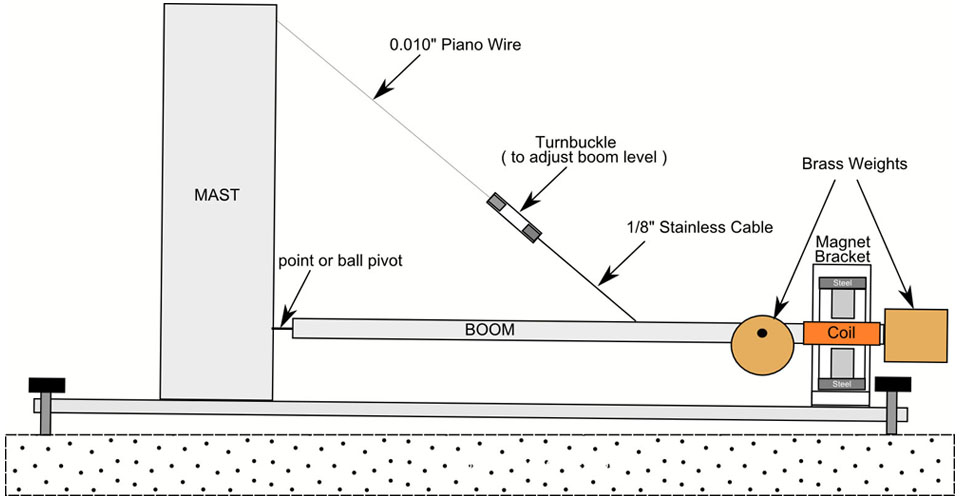 Basic Drawing This is an experimental and development structure built to try various combinations of magnets and coils. This is not any kind of final design. The magnet and coil are placed on the boom for easy changes to the magnet or to the coil. The Seismograph is a very simple version of the standard Lehman "garden gate" design. The updates are in the coil magnet, damper magnet assembly and the boom pivot. I am currently experimenting with a very powerful neodymium magnet set for the coil and magnetic damper. The boom is 45" long and the pivot is a very carefully chosen true tungsten carbide 0.5" square and 0.2" deep lathe insert. The boom point is a fairly sharp but softer carbide etching point. To date the pivot has shown no sign of wear and the boom assembly without the damping and coil magnets has an extremely free movement. I timed the movement time from 1 cm off center to a near stop at the center line and the time was 47 minutes (2800) seconds. This garden gate seems to swing forever! The mast to boom cable is connected to the boom at the approximate balance point of the boom with all weights, magnets, and copper in place. This balance point is chosen to reduce excessive downward pressure on the pivot point. I will be timing this free oscillation time regularly to see if any damage is being done by the point on the boom. But at this point I am sure the tungsten carbide is so much harder than the sintered carbide point on the boom that the point is simply being rounded just as a drill bit would be rounded if I were to try to drill a hole in with a tool steel drill bit in high quality tungsten carbide. All of the results of seismograph charts below are made with this version of the garden gate seismograph. I continue to experiment with both this sharp point pivot and a silicone nitride ball pivot joint. The period I am using (based on the angle of the base plate) is between 15 and 30 seconds. All construction is using aluminum plate of very heavy construction. As an example, the mast is 3" x 18" x 3/4" aluminum plate. The base plate is 4" x 5/8" x 45". The mast is bolted to the base plate with 3 heat treated 1/4-20 Allen head screws 2 inches long. New design based on A Bob McClure design - excellent I have just rebuilt my seismograph using Bob's 2002 design and the results to date are excellent. the basic website design is here: http://www.jclahr.com/science/psn/mcclure/horiz/horiz.html . This design is shown on JCLAHR's web site as a courtesy to Bob McClure's original work. I have gotten the basic system running but there is a lot detail work left to do such as magnet spacing and alignment. Full sized, partially simplified, drawing of my new seismograph: Here is a drawing with some areas simplified to show the detail of the construction of this version of my Lehman seismograph where the coil, magnet and damping are all under the boom and symmetrical about the center line of the boom. Since I am using a point suspension of the boom, balance of the boom is critical. I do use a double brass weight (not shown in the simplified drawings) near the end of the boom to fine tune the balance of the boom. 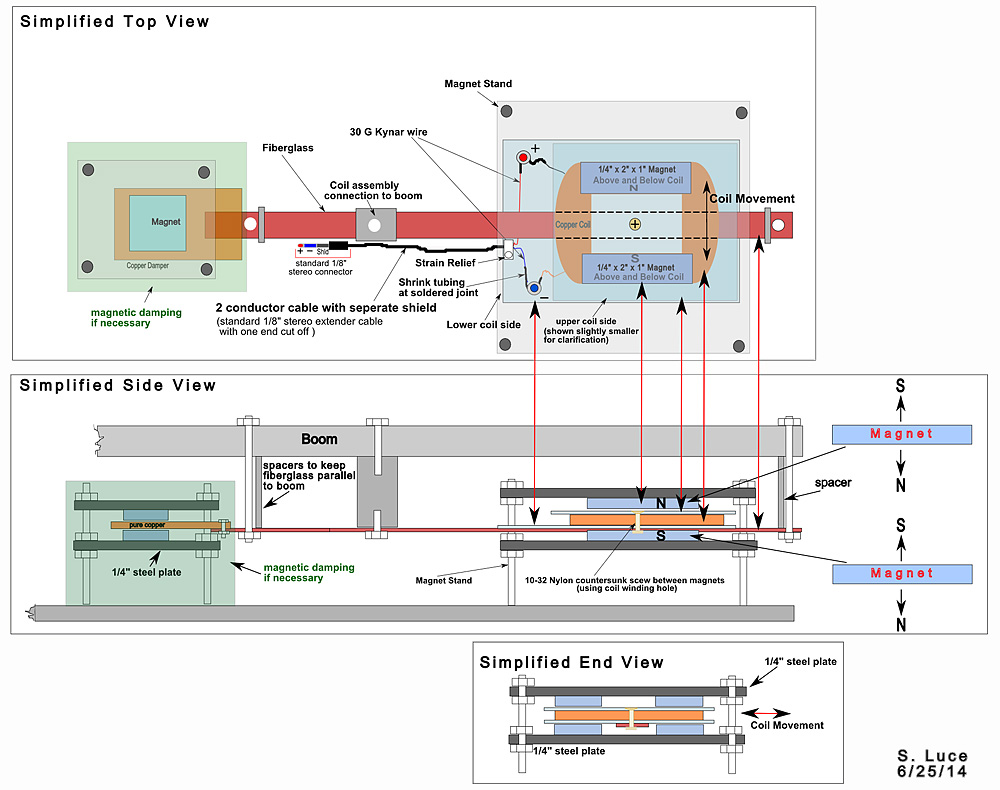 Early construction drawing with dimension detail: The magnetic sandwich design as some call it: 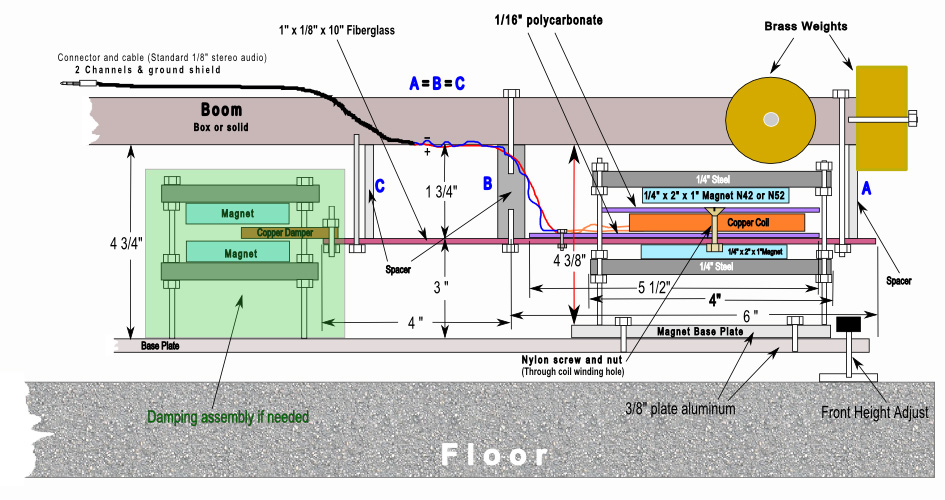 From reading my seismograph design history, this seems to be an early design originally developed by Bob McClure. My initial results using my 24 bit ADC are excellent but most of the credit goes to the mechanical design not the amplifier! The trick with this design is to squeeze the magnets as close to the rectangular coil as possible. I used 1/16" polycarbonate plastic as the rectangular coil sides and center. Polycarbonate is strong but can be 1/16" or even thinner. The tighter the magnet and coil the more intense the magnetic field. polycarbonate is very strong and also flexible so it does not break when holes are CAREFULLY drilled in the material. I am using a particular polycarbonate called "makrolon" which is available at TAP Plastics by the sheet or cut to size. There is no aluminum or "stainless" anyplace in the critical magnetic field areas. The magnet stand is steel. When the tolerances are this tight, the precision of the build of the components is critical. Any error in flatness or level will cause binding and a complete loss of a good signal. This design seems to be as good or better than my old large coil and double high powered magnets across one part of the coil. Coil Shunt Resistor Damping You may wonder what happened to the damping system in my first drawing! I am experimenting with the idea presented a few years ago which is called shunt coil damping. It is the process of finding a resistor value that can be wired in parallel with the coil in a magnet/coil design. This resistor has the ability to cause damping of the motion of the seismograph arm. Especially arms with long periods. Most commercial geophones now use this method. The problem is finding a resistor that can do 3 things at one time: 1. damp the system to some value of one or less - this is the primary goal. 2. present a combined impedance from shunt resistor and coil that will best match the first op amp input impedance requirements. 3. that will not increase system noise and hopefully might even reduce system noise. Accomplishing all three can not be done by mathematical analysis, as far as I know, so that simply means experimenting with resistor values that can give the best possible results of the three circuit requirements mentioned above. I also believe this damping method depends on having a lot of copper in the coil and very strong magnets. In my reading of many well written articles on seismograph circuits, very little attention is paid to the first op amp impendence requirements. In fact I found a paper that changed the first op amp in a commercial seismograph with three different op amps and got three very different results from the commercial seismograph simply based on the variation of effects of output coil impedance and good and bad op amp input impedance requirements. The essential issue here is that very few op amp manufacturers define op amp input impedance matching methods with sources ranging from thermocouples to high impedance sensors. I am very interested in hearing from others who have actually experimented with this process - I realize that a person's first impression would be surprise at best. One of the best ways to see this in idea action is to place the resistor in parallel with a coil in a working horizontal seismograph or geophone system and measure the period. Then remove the system magnets (if possible with a geophone) and resistor and measure the period - there is likely to be a considerable difference! |
|
Seismograph Examples AN M5.1 EXAMPLE The images below are samples from a 24 bit ADC seismograph. The image is a section of a recent event in Galeana Mexico. This event was about 1625 miles south of my seismograph. This is only a sample and the seismograph was not tuned or set up for this event. As I develop this page I will give more information on the design including the newest circuit used for this data. The ADC is a LTC2440 capable of 7 to 880 samples per second. The setting for this seismograph below was at 7 samples per second. There is a very good reason to run at this sample rate and that is an ultra low noise level. At 7 samples per second, the ADC noise is 200 nanovolts and that low noise level significantly contributes to a very low overall noise level of the final seismograph. A second factor is important to understand and that is the seismograph below was displayed on a dual monitor Windows 7 PC. In a dual monitor mode, and using the AmaSeis event display program, the image can be spread over both monitors at the same time making the image 1100 by 3800 with the monitors I am using. The image below is not stitched - it is a single image 1100 x 3800 pixels in size taken from a STRETCHED AmaSeis window. As I develop this web page, I will explain more about the dual monitor system and include more on the exact construction of the seismograph including the details of the circuits and the mechanics of the seismograph. My work with this seismograph has been with the guidance of several seismology experts and I deeply appreciate their help. This Galeana Mexico event happened to be a good application of my seismograph because of the length of the event. I have placed the image on this site for a single and quick example of the seismograph results. Galeana Mexico is about 1625 miles south of my seismograph and in exactly the wrong orientation to my equipment. My "garden gate" is sitting north/south and is generally most sensitive to events to the east or west of my machine. If you have questions, you can email me at Steve@steveluce.com. Steve |
Here is a recent M6.2 a near the Balleny Islands region which is south east of Australia and about 7,300 miles from my seismograph.
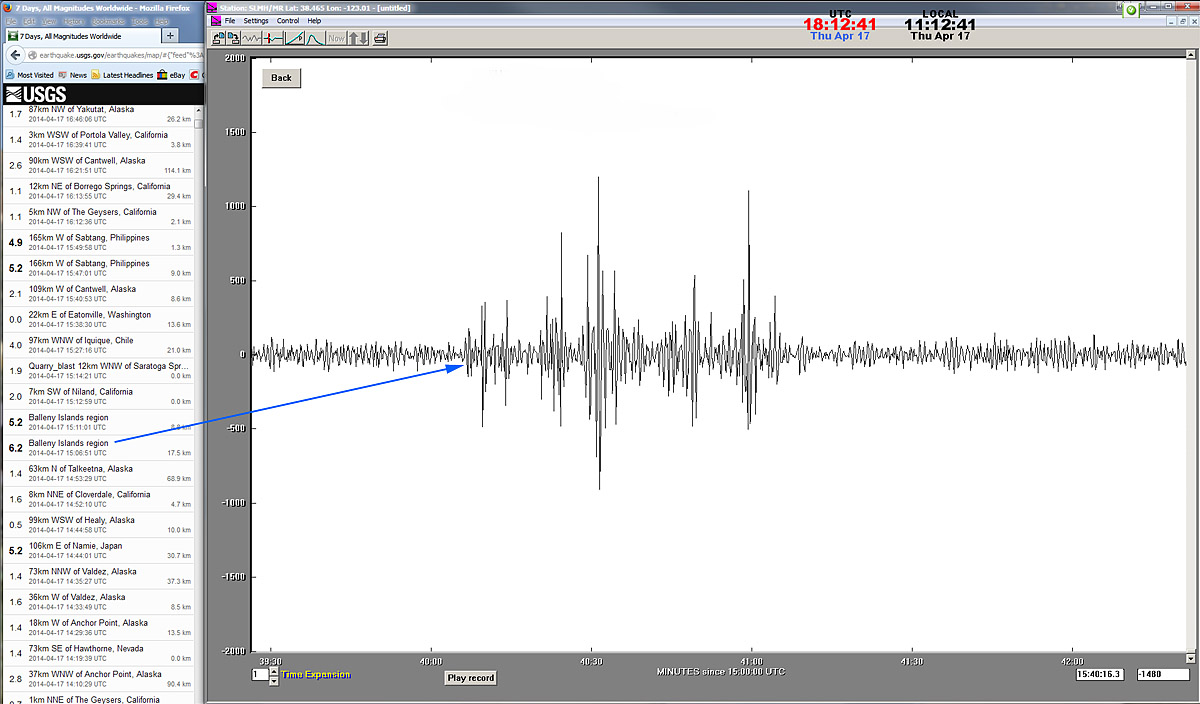
Here is a M3.0 in Larsen Bay, Alaska and about 1900 miles north west of my system.
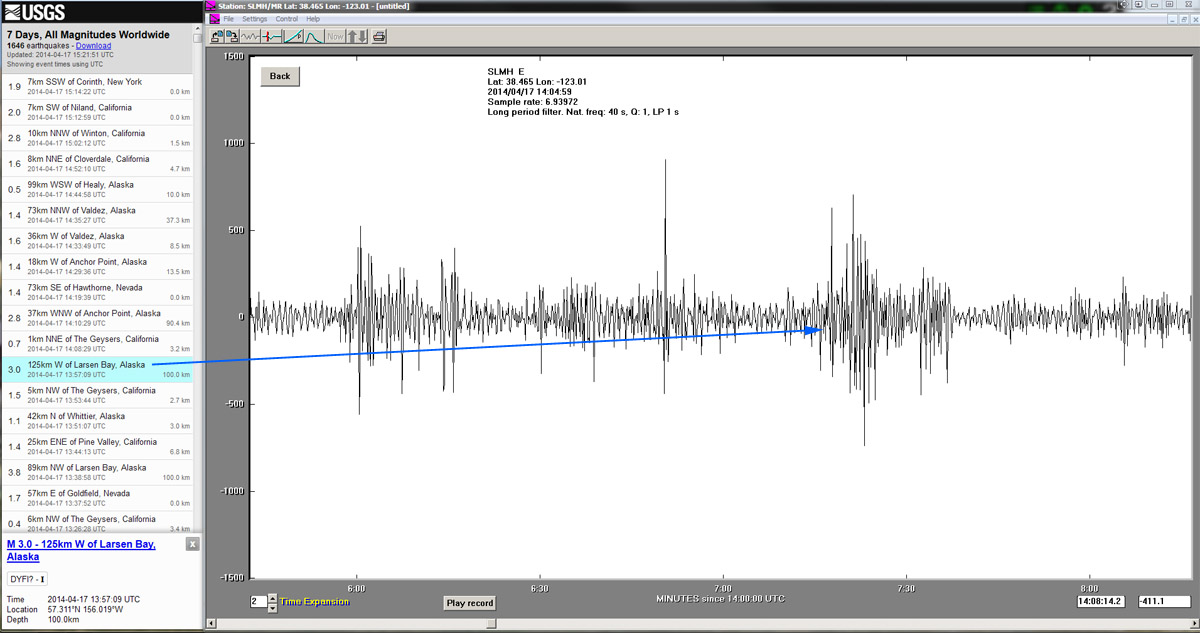
Here is a raw screen capture of an M3.6 on AmaSeis. The earthquake was in Napa Valley, about 40 miles East of my system
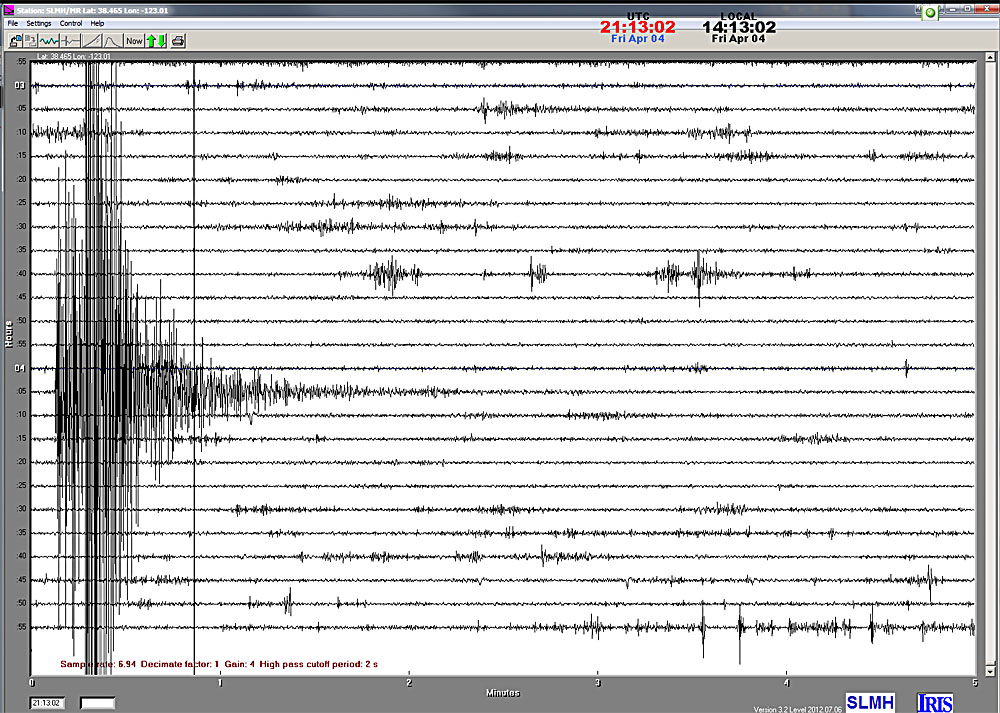
Additional examples of recent events including a comparison of vertical and horizontal seismographs of the same earthquake.
|
SEISMOGRAPH CIRCUIT |
||
Please note: If you want to see more electronic detail including simplified start up schematics, working code, and a more general application of the LTC2440 please take a look at this page: LTC2440 APPLICATIONS, SCHEMATICS, AND CODING |
||
|